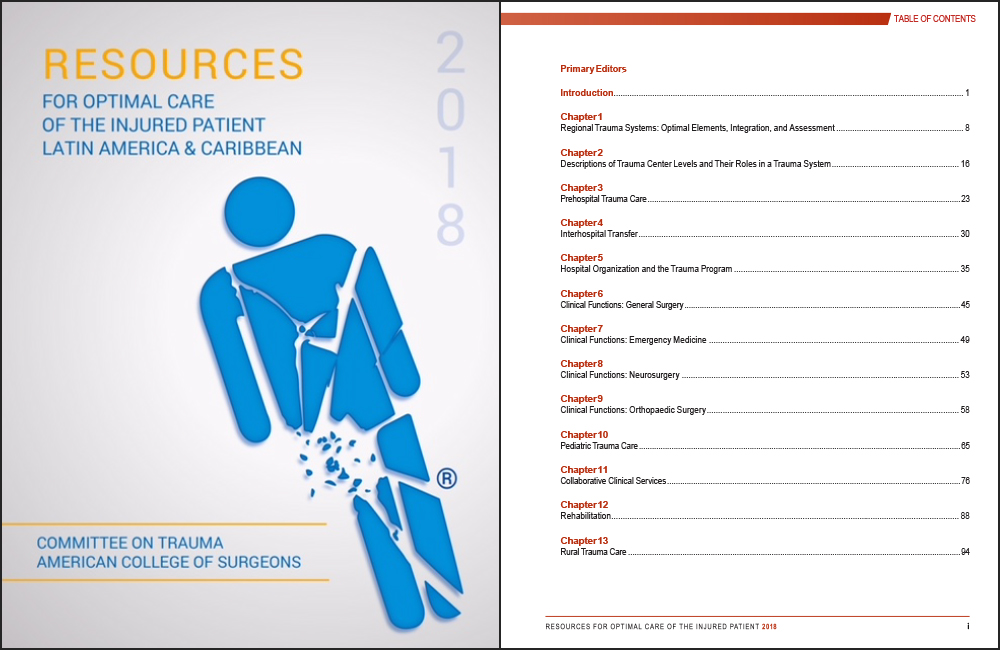
Resources for Optimal Care of the Injured Patient in Latin America and Caribbean
1976 was a key year in the evolution of care of the injured patient. In that year, Dr. Donald Trunkey and the American College of Surgeons Committee on Trauma (ACS COT) laid out the first list of criteria to define the essential elements of a trauma center. This simple optimal resources document led directly to the development of the ACS COT’s Verification Review and Consultation (VRC) program, which has grown to 510 verified trauma centers across the United States. The same year, orthopaedic surgeon Dr. James Styner and his family were tragically injured in a plane crash in a rural Nebraska cornfield. The lack of trained personnel and resources available to care for his family compelled Dr. Steiner and his colleague, Dr. Paul “Skip” Collicott, to develop “Advanced Trauma Life Support (ATLS)”, with the goal of ensuring that surgeons providing injury care would know what to do when confronted with an injured patient. ATLS was quickly adopted and aggressively promulgated by the ACS COT, and has grown to become a global movement. The first course was held in 1980, and since that time ATLS has been diligently refined and improved year after year, decade after decade, with more than a million students taught world-wide.
These two programs, the VRC and ATLS have transformed the care of injured patients across the globe, resulting in hundreds of thousands of lives saved. Although ATLS was intended as an educational program, and the VRC was intended to be a set of standards, ATLS has standardized the care of trauma patients and the VRC educated the trauma community in the US on how best to provide optimal care for trauma patients. Now 60% of ATLS classes are held outside of the US, taught by local faculty based on the same central principles. By contrast, the concept of trauma center verification established by the VRC as not been established outside of the US.
Ultimately, reducing injury death and disability at a public health level requires a multifaceted, integrated approach, one that includes prevention, prehospital care, a network of definitive care facilities, and resources for rehabilitation. While training providers in injury care is an essential step, trained providers have limited impact without the other essential elements of a trauma system, especially a network of capable trauma centers. The development of a trauma system cannot be driven by ATLS education alone; an organized trauma center verification program, such as the VRC, is equally critical.
In 2015, Dr. Maria Fernanda Jimenez, the Chair of the International Injury Care Committee (I2C2), reached out to the ACS COT asking to move forward with a translation of the current Optimal Resources for Care of the Injured Patient 2014. This initial aim of translating the document led to a discussion involving the ACS COT Executive Committee, the Trauma Systems Evaluation and Planning Committee (Robert Winchell) and the Verification, Review and Consultation Committee (Rosemary Kozar) to discuss the strategy and goals of the project. Following these discussions and with the unanimous support of the ACS COT Executive Committee, a pilot program in Region 14 (Latin America and the Caribbean) moved forward with three primary goals: 1) translate the Optimal Resources document to Spanish and Portugese; 2) use the translated document as a framework to establish a verification system relevant to Latin American and the Caribbean; and 3) pilot a verification process and structure in the Region. It was recognized that the Optimal Resources for Care of the Injured Patient 2014 standards could be literally translated; however, the processes and requirements would not be directly applicable to another country or region outside the US due to a wide variety of cultural and societal differences (e.g. laws, professional certifications, culture, and specific resource availability). Although the ACS COT Executive Committee and the leadership of Region 14 recognized not all the specific criteria would be directly relevant or applicable to the Region, Dr. Jimenez and the surgeons in I2C2 and Region 14 committed to a trauma center/system verification process modeled on exactly the same principles established in the United States: 1) setting relevant, high standards which elevate care; 2) ensuring the right resources, structure, processes and leadership are present; 3) using clinical data (ideally risk adjusted) for performance Improvement and outcome assessment; and 4) verifying that the standards are being met by an independent, rigorous and objective external review by clinical experts.
Specifications
- Last Updated: 2018
- Author(s): American College of Surgeons
- Category: Guidelines
- Tags: 2018, American College of Surgeons, English, Portuguese, Spanish
PDF Documents
Please login to access file downloads.
